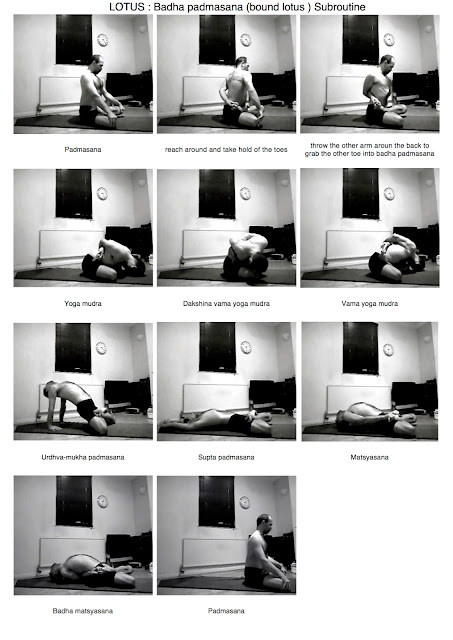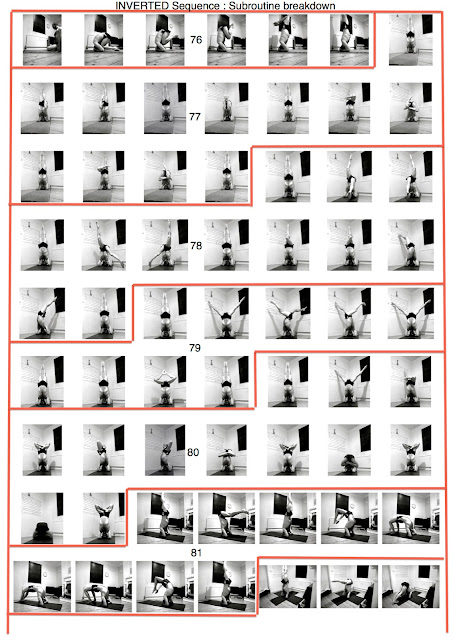 |
| VIDEO LINK |
To get up into Shoulder stand while in Lotus, bring you arms to your side, exhale fully and press your arms down into the mat, hold and roll the lotus up to your chest, aim your knees at a 45 degree angle up over your head and stretch/push your knees up into shoulder stand while shifting your hands to your hips and then your back either side of your spine with the fingers pointing up and the elbows not too far apart.
Alternatively, Start from regular shoulder stand, spread the legs apart, drop the left leg back a little, bring the right foot to the left thigh by rotating at the hip then bring the left foot to the right thigh again through the rotation of the hip.
Engage mula and uddiyana bandha at the end of the exhalation sucking in the belly to create more space to lower your lotus down to your chest.
Remember in Vinyasa Krama you can work towards this, lowering a little way on the first exhalation, take it back up on the inhalation, lower a little further on each exhalation.
When lowering your need to make sure your hips are high and over your shoulders or you will tend to roll back down to the mat.
Pindasana (pic 4) The fold needs to be deep, use the bad has, sucking your belly back and up into your ribcage to create space. your inhalations will be short but try to keep your exhalations long.
Ultimately your want to wrap your arms around your lotus and bind at the wrist, this requires a deep lotus with the feet high up in the groin and heels digging into the belly.
If your lotus is not as tight then bind at the fingers or just hold the thighs.
Twists
From udrdhava padmasana (lotus shoulderstand) Stretch up through the pelvis lengthening the body as much as possible, twist on the exhalation and lower/fold your knee to the outside of your forehead.
Again, work a little lower on each exhalation
Remember to keep the hips high and over the shoulders to prevent rolling back.
Counterpose (pic 8) There are two hand positions, the one in the picture with the palms supporting the sacrum and the another where the thumbs point toward but remain outside of the spine, resting lower down on the back of the hips with the fingers coming around the hip bone. I tend to prefer the later.
This is a back stretch so tuck the tailbone under and to counter the weight of the legs by pushing the chest out and up, engage jalandhara bandha (chin lock) firmly.
The posture is entered on the inhalation by bending from the waist and arching the back.
Stay in the position for three breaths, perhaps going a little deeper into the pose each time or go back and forth to akunchita urdhva padmasana (pic 3) and the counter pose on the breath if holding is too challenging.
Simhasana Subroutine VIDEO LINK. From Akunchita urdhave padmasana, stretch out the arms above your head, roll your lotus slowly down to the mat, keep the momentum to bring your arms up and over passing through regular lotus as you put your hands to the floor and come up on to your knees. Lower your body flat to the floor stretch your arms out in front of you, palms together as if in prayer.
Place the palms on the mat beside you close to your chest. Tuck the tailbone (this is a back stretch) anchor the knees, try to bring the hips as close to the mat as possible , arch the back stretching out through the waist. Stretch out through the full length of your body, pushing out your chest take the head back. The is a Bhujangasana variation and can be worked on in the Bow sequence subroutines.
 |
| Another Lion face variation |
Lions face. Inhale stretching back the head and as you exhale make a long Haaa sound while stretching your tongue out and down and widening the eyes. Focus your attention on the mid brow.
You may like to repeat this three times, closing the mouth on the inhalation and taking the head back before repeating the lions face on the exhalation.





















